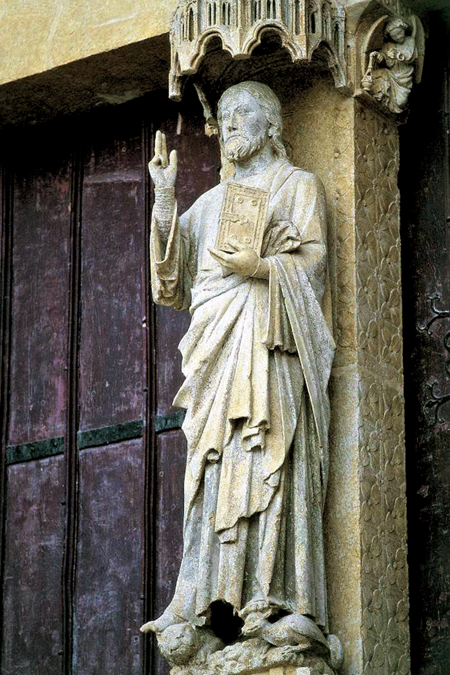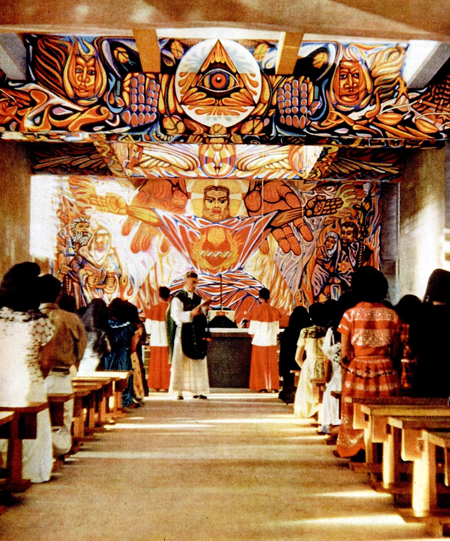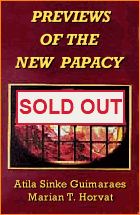Art & Architecture
 |
 |
 |
 |
 |
 |
 |
The Formative Power of Iconography
A generally accepted principle in iconography – which is in fact the result of simple common sense – states that the features and bearing of the images should reflect the virtues of the persons they represent. In this way, art contributes to the moral formation of the faithful.
This principle, which implies attributing to art a true mission in the sanctification of men, cannot be questioned by any balanced Catholic with common sense. It is confirmed by the sentiments of Catholics of all generations, by Tradition and by Revelation. In every age Christian art understood that images should express holiness.
It was always considered that it was a grace of exceptional sanctification for the contemporaries of Our Lord and Our Lady to actually know their ineffably virtuous faces. At the time of the Transfiguration, the splendor that radiated from Our Lord, Moses and Elias undoubtedly expressed not only the glory, but also the infinite sanctity of Christ and the eminent holiness of the two others.
In short, there is nothing more solid, evident, positive and universally accepted in matter of iconography than this principle.
*
 This explains why certain images, through the grace of God, have done so much good for souls that they have even caused conversions.
This explains why certain images, through the grace of God, have done so much good for souls that they have even caused conversions.
It would not be difficult to admit that an image like the one in our first picture raises profound feelings of reverential fear and love of Our Lord.
• Of fear, because the strength and gravity of the bearing, the nobility of the gesture and the countenance, and the strong majesty of King and Master that emanates discreetly from this figure, all naturally inspire in us a humble sense of our inferiority, animate the conviction of our imperfections and make us see how vile, petty and objectionable they are.
• Of love, because such grandeur coexists with a simplicity so extreme, an interior order so harmonic, an equilibrium so perfect and a suavity so profound that they impose admiration and a limitless confidence, in short, love.
*
But, if there are images that can do us good, there are unfortunately also those that can have a bad effect.
 Who would say that this brutal and ferocious acrobat who seems to be executing a violent dance step, dressed in cacophonous garb and supported by two cyclopean and misshapen hands, could be Our Lord Jesus Christ, who is sanctity itself and, therefore, has an infinite temperance, dignity, elevation and nobility?
Who would say that this brutal and ferocious acrobat who seems to be executing a violent dance step, dressed in cacophonous garb and supported by two cyclopean and misshapen hands, could be Our Lord Jesus Christ, who is sanctity itself and, therefore, has an infinite temperance, dignity, elevation and nobility?
If this sinister, violent, extravagant idol were to be understood as the ideal of moral perfection, it would be undeniable that one would be stepping away from the path of holiness. So much so that art, even when it is called Catholic, can implicitly convey grave and even fatal errors against Catholic morality.

This principle, which implies attributing to art a true mission in the sanctification of men, cannot be questioned by any balanced Catholic with common sense. It is confirmed by the sentiments of Catholics of all generations, by Tradition and by Revelation. In every age Christian art understood that images should express holiness.
It was always considered that it was a grace of exceptional sanctification for the contemporaries of Our Lord and Our Lady to actually know their ineffably virtuous faces. At the time of the Transfiguration, the splendor that radiated from Our Lord, Moses and Elias undoubtedly expressed not only the glory, but also the infinite sanctity of Christ and the eminent holiness of the two others.
In short, there is nothing more solid, evident, positive and universally accepted in matter of iconography than this principle.

Le Beau Dieu, Cathedral of Amiens
It would not be difficult to admit that an image like the one in our first picture raises profound feelings of reverential fear and love of Our Lord.
• Of fear, because the strength and gravity of the bearing, the nobility of the gesture and the countenance, and the strong majesty of King and Master that emanates discreetly from this figure, all naturally inspire in us a humble sense of our inferiority, animate the conviction of our imperfections and make us see how vile, petty and objectionable they are.
• Of love, because such grandeur coexists with a simplicity so extreme, an interior order so harmonic, an equilibrium so perfect and a suavity so profound that they impose admiration and a limitless confidence, in short, love.
But, if there are images that can do us good, there are unfortunately also those that can have a bad effect.

If this sinister, violent, extravagant idol were to be understood as the ideal of moral perfection, it would be undeniable that one would be stepping away from the path of holiness. So much so that art, even when it is called Catholic, can implicitly convey grave and even fatal errors against Catholic morality.

Catolicismo, n. 56, August 1955
Posted December 28, 2018
Posted December 28, 2018
______________________
______________________
 Volume I |
 Volume II |
 Volume III |
 Volume IV |
 Volume V |
 Volume VI |
 Volume VII |
 Volume VIII |
 Volume IX |
 Volume XI |
 Special Edition |
 Special Edition |


